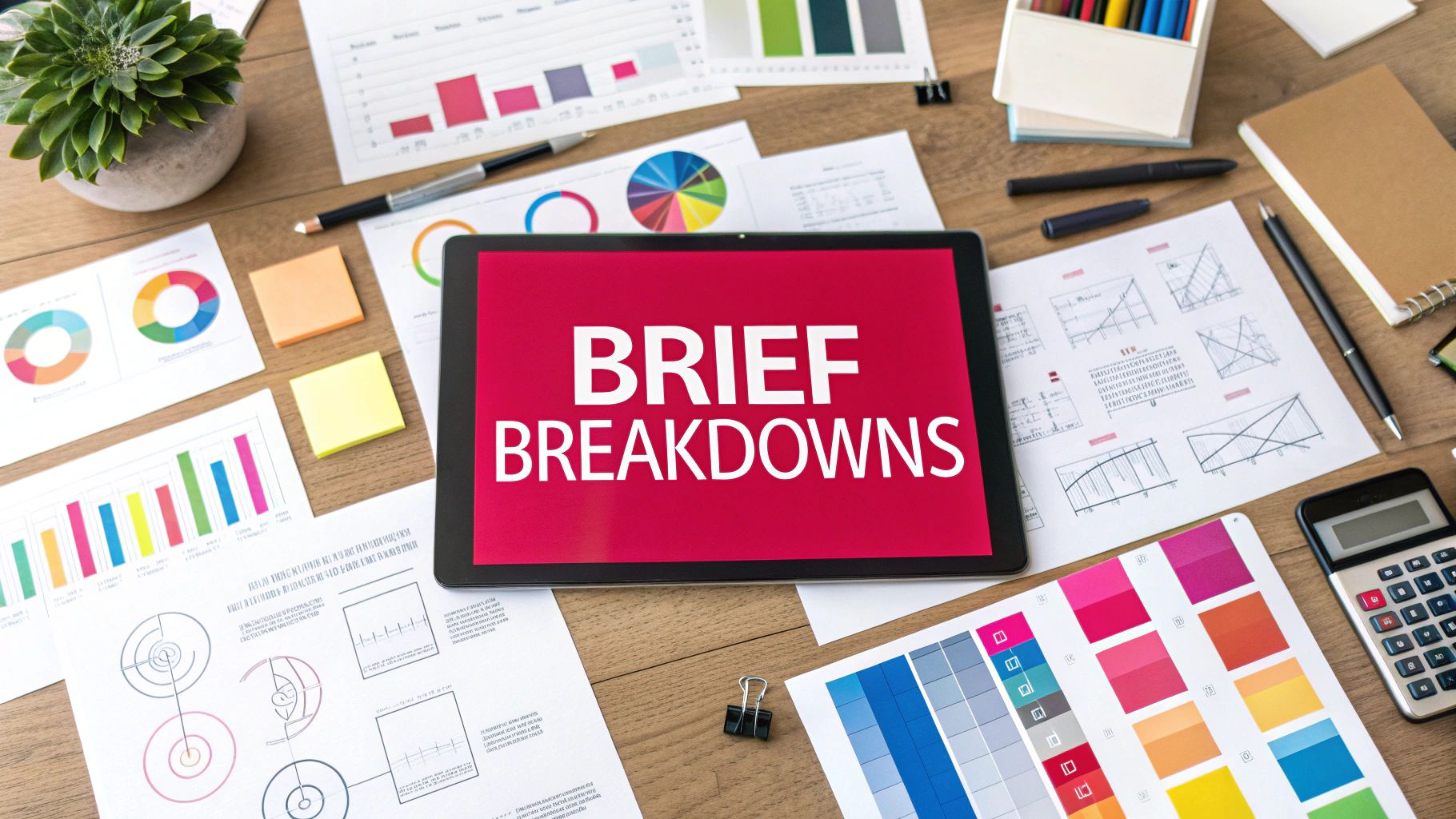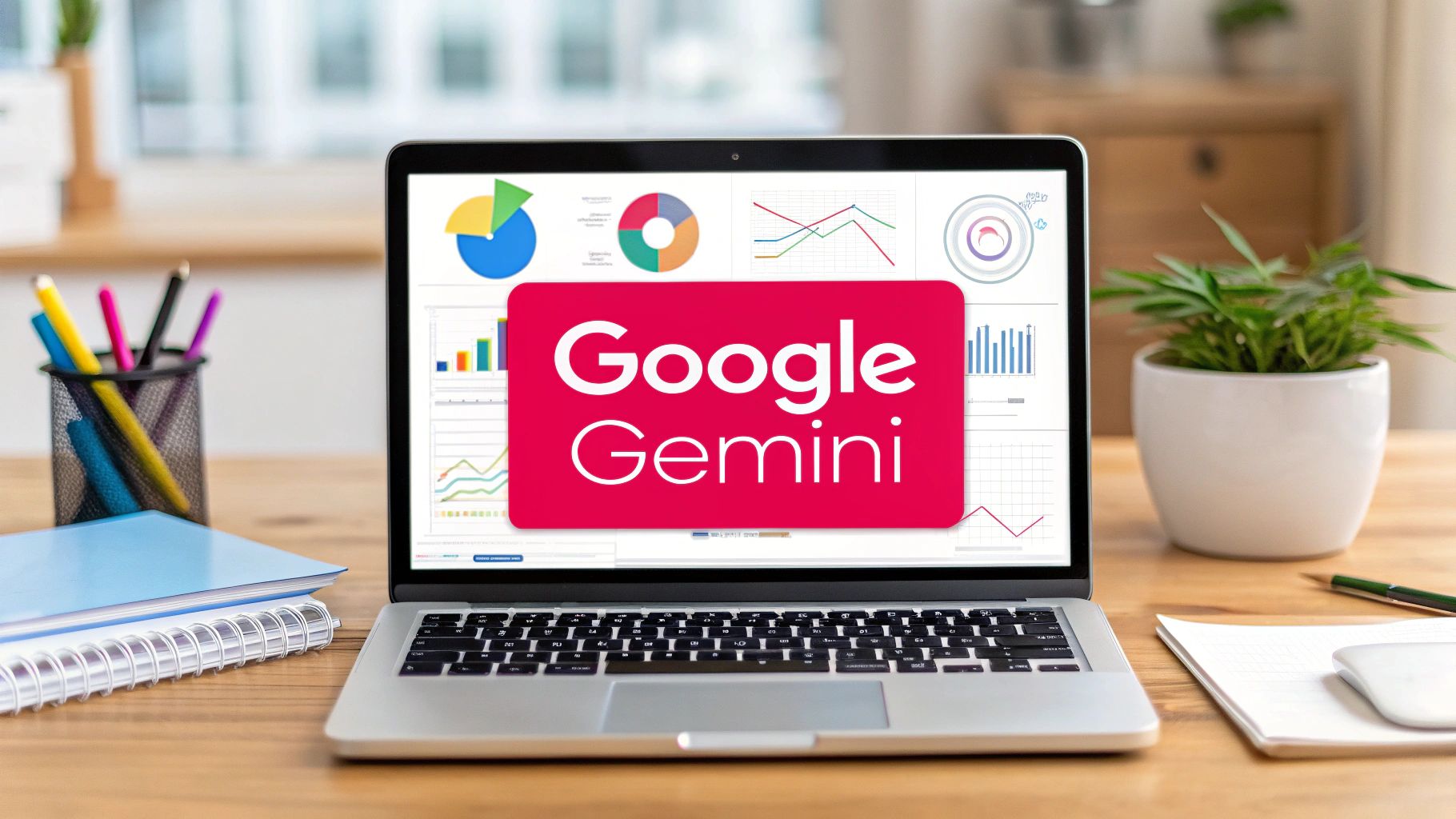From Blank Page to Iconic Campaign: The Power of a Perfect Creative Brief
Every legendary marketing campaign, from Nike's 'Just Do It' to Spotify's 'Wrapped', began with a single document: the creative brief. This foundational tool is the strategic blueprint that transforms a business objective into creative magic. It aligns teams, clarifies goals, and sets the stage for work that resonates, inspires, and converts. Crafting a truly effective brief is an art form. It is about more than just filling in boxes; it is about asking the right questions, defining the core problem, and inspiring a creative team with a clear, compelling vision.
In this deep dive, we will dissect seven iconic creative brief examples. We will not just look at what they produced; we will reverse-engineer their strategic brilliance, uncovering the key components, psychological triggers, and actionable insights you can apply to your own projects. Prepare to move beyond theory and learn from the masterclasses that shaped modern marketing. To truly understand the impact of a perfect brief, it is helpful to explore more top brand storytelling examples that have captivated audiences worldwide.
This guide provides the tools to craft briefs that do not just guide, but ignite creativity. For businesses in the UAE and beyond, understanding the nuances of these briefs is crucial for delivering bespoke, data-driven strategies that captivate audiences and achieve tangible results.
1. Nike 'Just Do It' Campaign Creative Brief
The Nike ‘Just Do It’ campaign is a masterclass in transformational marketing, shifting the brand's focus from product specifications to pure, unadulterated emotion. The original 1988 creative brief, developed by the Wieden+Kennedy agency, was born from a need to broaden Nike's appeal beyond elite marathon runners to everyday fitness enthusiasts. The core insight was that the most significant barrier to fitness wasn't physical, but mental. This led to a brief centred on a single, powerful idea: overcoming self-doubt and the universal voice of procrastination that says, "I'll do it tomorrow".
The resulting campaign didn't sell shoes; it sold courage, determination, and the feeling of personal accomplishment. This is a prime creative brief example because it established a timeless brand ethos rather than a temporary slogan. From Michael Jordan's gravity-defying ads to the controversial but impactful 2018 Colin Kaepernick anniversary campaign, the brief's essence of celebrating conviction has remained the brand's North Star.
Strategic Analysis
The genius of the 'Just Do It' brief lies in its simplicity and universality. It defined the problem not as a lack of quality footwear, but as a lack of motivation. The target audience was expanded to include anyone with a body, making the message deeply personal and relatable. By focusing on the emotional benefit of "personal achievement" over the functional benefit of "cushioned soles," Nike created a powerful emotional connection that has transcended generations and cultures. This strategy effectively future-proofed the brand, allowing it to remain relevant through decades of societal and cultural shifts.
Actionable Takeaways for Your Brief
- Focus on the “Why,” Not the “What”: Dig deep to find the emotional problem your product solves. Instead of listing features, articulate the feeling or transformation your customer will experience.
- Create a Universal Enemy: Identify a common struggle your audience faces, like self-doubt, inertia, or complexity. Position your brand as the tool to conquer that enemy.
- Keep the Core Message Simple: The best briefs can be distilled into a short, powerful phrase. 'Just Do It' is memorable, actionable, and easily translated across different contexts and campaigns.
The following timeline illustrates the campaign's remarkable impact on Nike's market position, a direct result of this strategic shift.
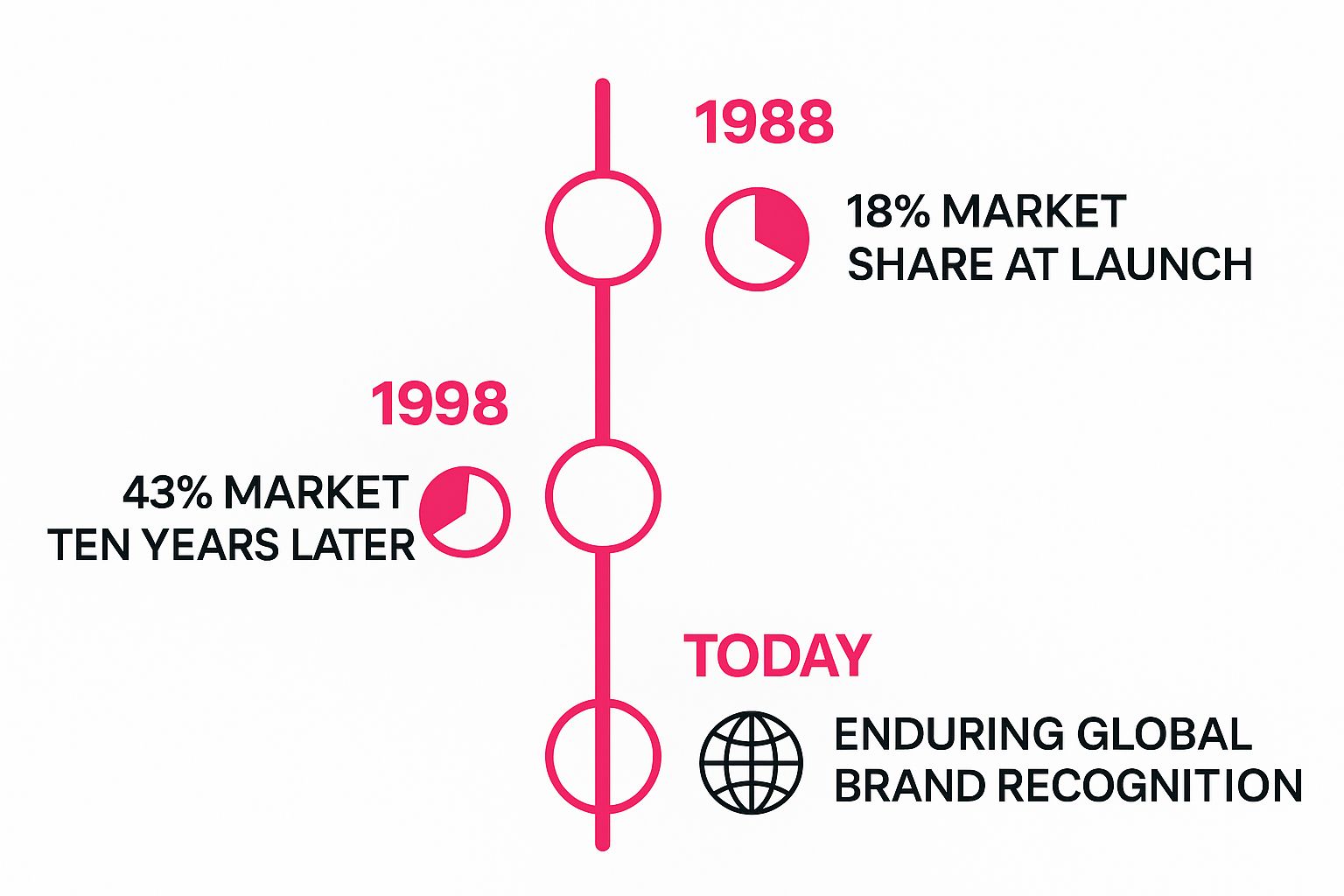
This visualisation clearly shows how a strong, emotionally resonant creative brief directly translated into a decade of explosive growth and enduring market dominance.
2. Apple 'Think Different' Creative Brief
Apple’s 1997 'Think Different' campaign marked a pivotal moment, rescuing the company from the brink of obscurity and redefining its brand identity for decades to come. The creative brief, developed by agency TBWA\Chiat\Day under the close watch of a returning Steve Jobs, was a direct response to Apple's struggling market position. The core problem wasn't the quality of its computers; it was the perception of the brand. The brief's central mandate was to stop talking about processors and megahertz and start celebrating the values of the people who used Apple products: the rebels, the artists, and the visionaries.
The campaign that emerged from this brief was a profound statement of purpose. It didn't feature a single product. Instead, it showcased black-and-white portraits of iconic figures like Albert Einstein, Martin Luther King Jr., and John Lennon. This is a powerful creative brief example because it successfully aligned the brand with a philosophy of non-conformity and creative genius, transforming Apple from a computer company into a symbol of innovation. It laid the groundwork for the brand's resurrection and future successes, from the iMac to the iPhone.
Strategic Analysis
The strategic brilliance of the 'Think Different' brief was its focus on brand purpose over product features. At a time when competitors were locked in a "speeds and feeds" war, Apple chose to champion an idea. It defined its target audience not by demographics, but by psychographics: a mindset of creativity and a desire to challenge the status quo. This approach established an almost cult-like following, making consumers feel like part of an exclusive club of innovators. The brief created a halo effect, where the brand's noble values were transferred onto its products, justifying their premium price and positioning Apple as the tool for those who aimed to change the world. More details on this revolutionary approach can be seen in other brand positioning examples.
Actionable Takeaways for Your Brief
- Align Brand Values with Customer Aspirations: Don't just sell what your product does; sell what it represents. Identify the core values of your ideal customer and make your brand a reflection of their highest aspirations.
- Use Icons as Shorthand: Find symbolic figures or ideas that instantly communicate your brand's philosophy. This creates a powerful mental shortcut for your audience, connecting your brand with established ideals.
- Establish a Creed, Not a Slogan: 'Think Different' was more than a tagline; it was a manifesto. Develop a core belief system for your brand that can guide all marketing efforts, from high-level campaigns to daily social media posts.
3. Dove 'Real Beauty' Campaign Creative Brief
The Dove 'Real Beauty' campaign, launched in 2004, represents a monumental shift in brand purpose, moving Dove from a simple soap brand to a global advocate for self-esteem. The creative brief, crafted by Ogilvy & Mather, originated from a profound insight: only a tiny fraction of women globally considered themselves beautiful. This identified a deep-seated cultural tension between the narrow, unrealistic portrayal of beauty in media and how real women perceived themselves. The brief was therefore not about selling soap, but about starting a global conversation and challenging toxic beauty stereotypes.
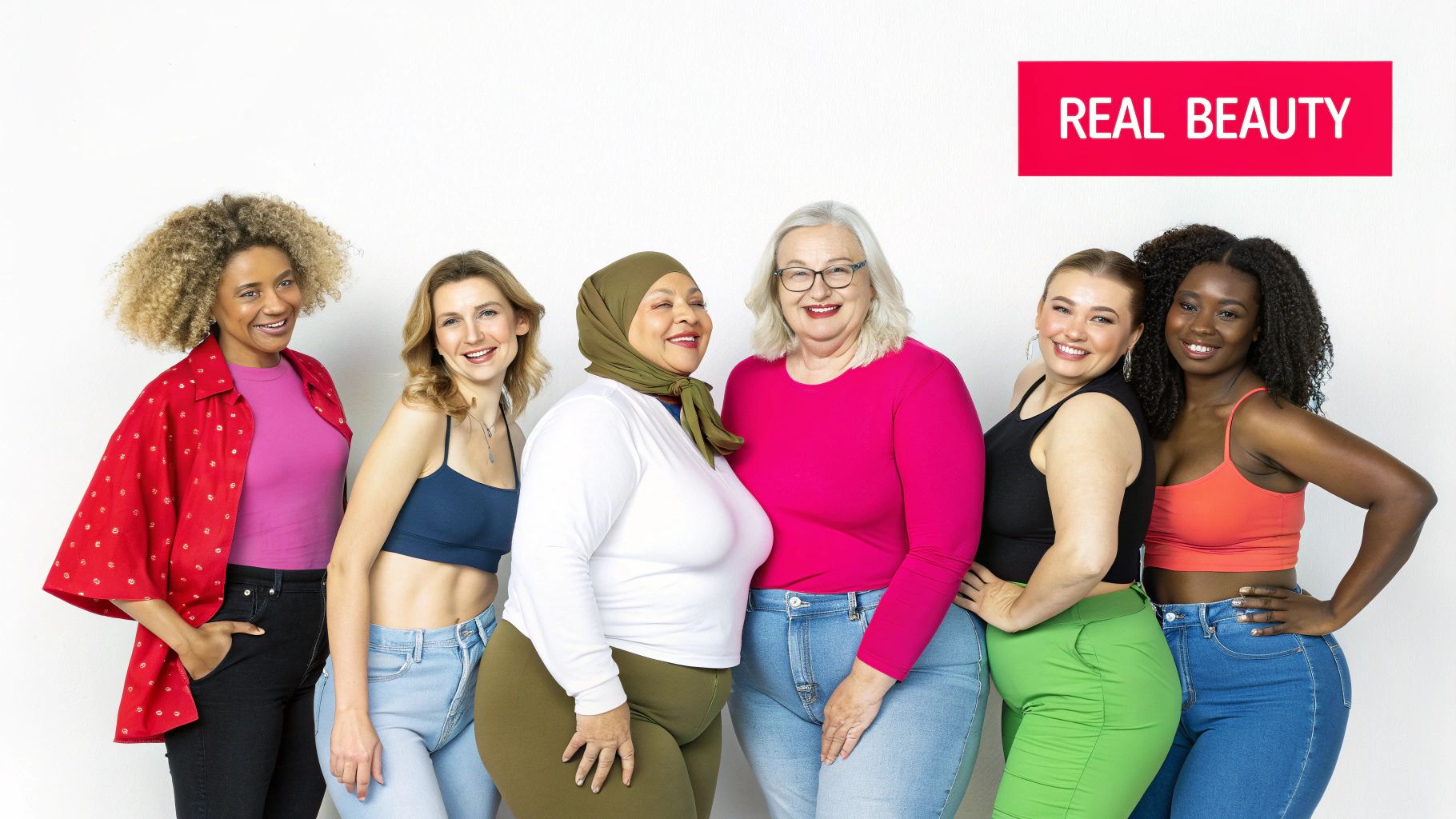
This mission was brought to life through groundbreaking initiatives like billboard campaigns featuring real, un-retouched women and the viral 'Real Beauty Sketches' video. The campaign's longevity and impact make its foundation a powerful creative brief example. It successfully connected a product to a larger social mission, fostering a level of brand loyalty that transcends product features. The brief's core idea was to build brand value by building women’s self-worth, a radical but deeply resonant approach.
Strategic Analysis
The strategic genius of the 'Real Beauty' brief was its authenticity and cultural relevance. Instead of creating a new ideal, it chose to celebrate the existing, diverse reality of its audience. The problem was defined not as "women need better soap," but as "women's confidence is being eroded by unrealistic beauty standards." This reframing allowed Dove to become part of the solution. The target audience was every woman who had ever felt insecure, making the campaign’s message universally potent.
By championing "real beauty" over "aspirational beauty," Dove forged an emotional bond built on empathy and validation. This purpose-driven strategy transformed the brand into a cultural movement, ensuring its message remained relevant and shareable, particularly with the rise of social media. The campaign became a case study in how a strong, purpose-led creative brief can generate earned media and organic conversation far beyond the initial advertising spend.
Actionable Takeaways for Your Brief
- Find Your Brand's Purpose: Look beyond your product's function to identify a larger societal or cultural issue your brand can authentically address. Align your mission with a genuine human need.
- Champion Your Audience: Instead of just selling to your audience, celebrate them. Make them the heroes of your brand story by reflecting their real lives, challenges, and values.
- Build a Conversation, Not Just a Campaign: Frame your brief around a core question or tension that invites participation. A great brief sparks dialogue that can live on across multiple platforms and initiatives.
4. Old Spice 'The Man Your Man Could Smell Like' Creative Brief
The Old Spice 'The Man Your Man Could Smell Like' campaign revitalised a legacy brand by completely upending its traditional image. The 2010 creative brief, orchestrated by Wieden+Kennedy, identified a crucial market dynamic: men were the primary users, but women were the primary purchasers of men's body wash. The brief’s core objective was to create a conversation between couples, using humour as the bridge. It aimed to reposition Old Spice from an outdated, "grandfather's brand" to one that was modern, confident, and hilariously self-aware.
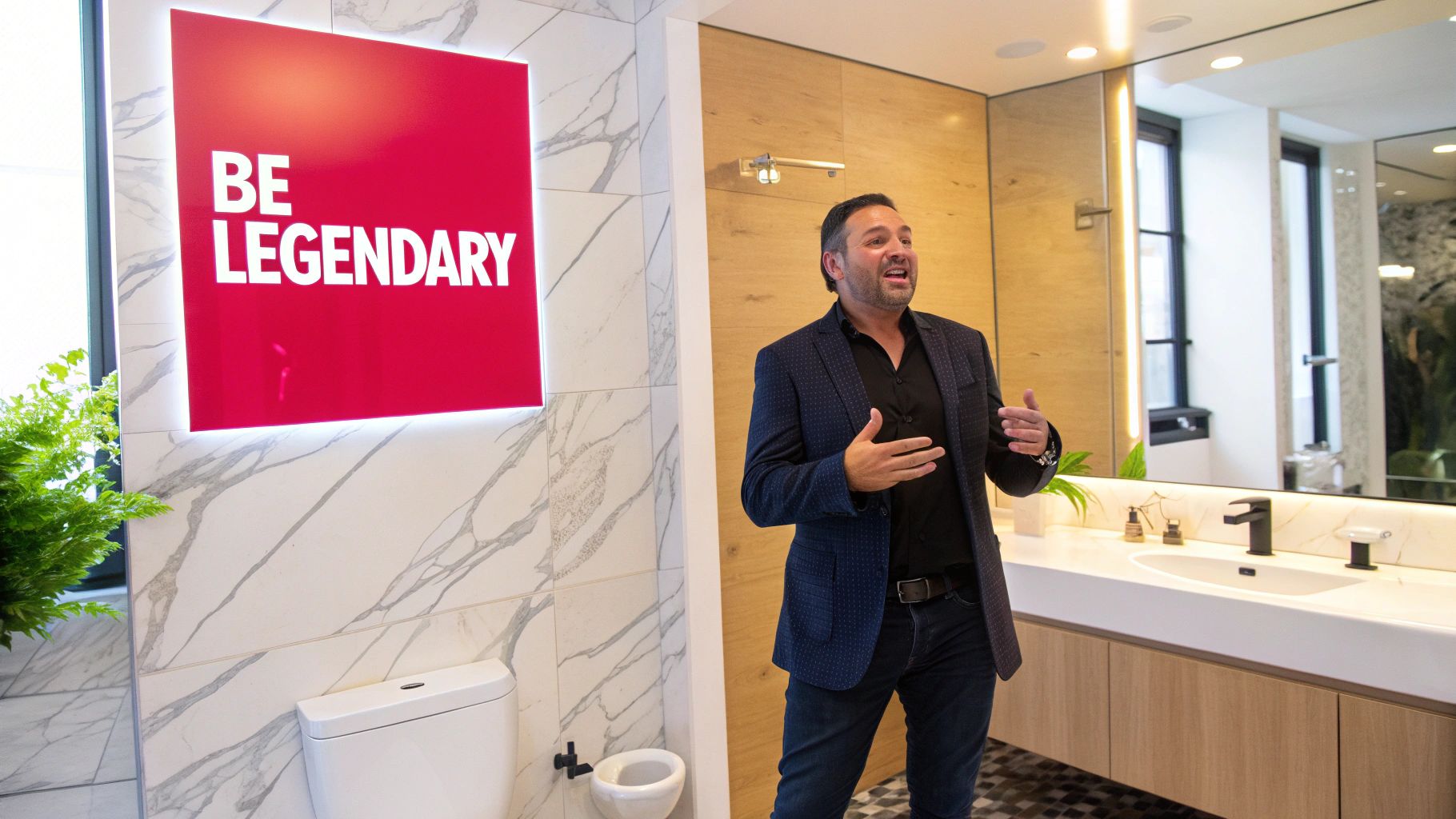
The resulting campaign, featuring actor Isaiah Mustafa in a series of surreal and fast-paced monologues, was an internet phenomenon. It wasn't just an ad; it was a piece of viral entertainment designed for the digital age, with a brief that specifically planned for social media amplification. This is a powerful creative brief example because it demonstrates how to successfully target two different audiences simultaneously by focusing on a shared sense of humour and aspiration. The campaign's success was cemented with a real-time social media response where "The Old Spice Guy" created personalised video replies to fans on Twitter, a groundbreaking move at the time.
Strategic Analysis
The genius of this brief was its dual-audience insight. Instead of creating separate messages, it crafted a single, brilliant one that appealed to women's desires and men's aspirations with a wink. The problem wasn't that the product was bad, but that the brand was irrelevant. The solution was to create content so entertaining that it became a cultural talking point. The strategy was to use absurdist humour to present an impossibly perfect ideal of masculinity ("I'm on a horse") that was so over-the-top it became aspirational rather than intimidating. This approach redefined the brand’s voice and made it a key player in the digital conversation.
Actionable Takeaways for Your Brief
- Identify the Purchaser vs. the User: If the person buying your product isn't the end-user, your brief must address the motivations of both. Find the common ground where their interests intersect.
- Weaponise Humour with Purpose: Use humour that reinforces the brand promise, not just for a cheap laugh. Old Spice’s humour communicated confidence and charm, which were core to its new identity.
- Plan for Virality and Interaction: Don't just hope your campaign goes viral; build mechanisms for it. The brief should consider how the campaign will live and breathe on social media from day one, encouraging shares and engagement.
- Develop a Character, Not Just a Campaign: Creating a memorable persona like 'The Old Spice Guy' allows the campaign to evolve into a series, keeping the audience engaged over a longer period than a one-off advertisement.
5. Airbnb 'Belong Anywhere' Creative Brief
Airbnb's 2014 'Belong Anywhere' campaign was a pivotal rebranding effort that transformed its public perception. The creative brief, developed internally with branding agency DesignStudio, aimed to shift Airbnb from a transactional, budget-friendly accommodation service to a global community built on human connection. The core insight was that modern travel often left people feeling like outsiders. This brief challenged that notion, proposing that Airbnb could offer something hotels never could: a genuine sense of belonging. The goal was to articulate a brand purpose that went far beyond renting a room.
The campaign's success came from its focus on community and shared experiences rather than just transactions. This is an exceptional creative brief example because it successfully redefined a business category. Instead of selling stays, Airbnb started selling the idea of living like a local and feeling at home anywhere in the world. Initiatives like the host story documentary series and disaster relief accommodation programmes were direct outputs of this brief, demonstrating the brand's commitment to community, not just commerce.
Strategic Analysis
The strategic genius of the 'Belong Anywhere' brief was its human-centric positioning. It identified a deep-seated human need for connection and positioned Airbnb as the facilitator of that connection. The target audience evolved from budget travellers to anyone seeking authentic, meaningful experiences. The problem it solved was not a lack of places to stay, but the feeling of alienation that often accompanies travel. By shifting the focus to the emotional benefit of "belonging" over the functional benefit of "affordable lodging," Airbnb forged a powerful brand identity that resonated on a deeply personal level.
Actionable Takeaways for Your Brief
- Build a Community, Not Just a Customer Base: Frame your brand's purpose around a shared value or belief system. What brings your audience together beyond the purchase of your product?
- Leverage Authentic Stories: Your customers are your best storytellers. Build campaigns that feature real user experiences to demonstrate your brand's values in action, rather than just stating them.
- Integrate Purpose into Your Business Model: The brief's power came from its integration into Airbnb’s operations, from host policies to social responsibility programmes. Ensure your brand purpose is reflected in your actions, not just your ads. This approach aligns closely with creating a comprehensive marketing plan. You can find more details in this marketing plan example.
6. Patagonia 'Don't Buy This Jacket' Creative Brief
Patagonia’s 2011 'Don't Buy This Jacket' campaign is a landmark example of brand activism and a radical redefinition of marketing success. On Black Friday, the busiest shopping day of the year, Patagonia took out a full-page ad in The New York Times featuring their best-selling R2 Jacket with a bold headline: "Don't Buy This Jacket". The creative brief behind this move was audacious, seeking to directly confront the culture of hyper-consumerism and position Patagonia not as a retailer, but as a partner in environmental stewardship.
The core insight for this creative brief example was a paradox: the brand's most committed customers loved Patagonia for its environmental ethos, yet the act of buying new products, even from a responsible company, contributes to environmental degradation. The brief aimed to resolve this tension by shifting the marketing goal from driving short-term sales to fostering a long-term movement of conscious consumption. The resulting campaign reinforced the brand’s mission, sparked a global conversation, and ironically led to increased sales and brand loyalty, proving that purpose can be more powerful than promotion.
Strategic Analysis
The strategic genius of the 'Don't Buy This Jacket' brief lies in its unflinching authenticity and strategic use of controversy. It was a high-risk, high-reward move that perfectly aligned with Patagonia's long-established corporate philosophy, championed by founder Yvon Chouinard. The problem it defined was not a lack of market share, but a societal addiction to disposable goods. The campaign deliberately targeted an audience that was already environmentally aware but needed a catalyst to change their purchasing behaviour.
By telling people not to buy, Patagonia created a powerful filter, attracting customers who shared its values and were willing to invest in products built to last. This strategy transformed the customer relationship from transactional to collaborative. It was followed by tangible programmes like Worn Wear, which encourages repair and resale, proving the campaign was a deeply held conviction, not just a clever marketing ploy. This approach solidified Patagonia’s reputation as a true leader in sustainability, creating a moat of brand loyalty that competitors cannot easily replicate.
Actionable Takeaways for Your Brief
- Align Message with Mission: Your most powerful marketing comes from your core values. Ensure any bold campaign statement is backed up by genuine and demonstrable company actions.
- Educate, Don't Just Sell: Use your brief to frame a bigger conversation. Instead of focusing solely on product benefits, educate your audience on the broader implications of their choices and position your brand as a guide.
- Embrace Strategic Controversy: A provocative message can cut through the noise, but it must be purposeful. Use it to challenge industry norms or spark dialogue on an issue that matters to your core audience.
- Build Value Beyond the Purchase: Focus the brief on creating long-term brand equity. Ask how the campaign can foster a community or a movement, turning customers into advocates for a shared cause.
7. Spotify 'Wrapped' Campaign Creative Brief
Spotify's annual 'Wrapped' campaign is a masterclass in data-driven, personalised marketing that has become a global cultural phenomenon. The campaign's creative brief centres on transforming individual user data, which could feel intrusive, into a celebratory, highly shareable year-in-review experience. The core insight is that users feel a deep personal connection to their listening habits, and presenting this data back to them in a fun, visually appealing format fosters a sense of identity and community. This brief is not about selling a new feature; it is about reinforcing user loyalty by celebrating their unique journey with the platform.
The resulting campaign is a powerful engine for organic social media engagement. Each year, Spotify delivers shareable story-style cards detailing top artists, songs, genres, and podcasts, which users eagerly post across their networks. This is a brilliant creative brief example because it turns every user into a brand ambassador. By creating anticipation with consistent annual timing and balancing personal stats with broader global trends, the 'Wrapped' brief has engineered a powerful, self-perpetuating marketing loop that reaffirms Spotify's place in its users' lives.
Strategic Analysis
The genius of the 'Wrapped' brief is its ability to create FOMO (Fear Of Missing Out) on a massive scale. It leverages the psychological principle of social proof by making personal data public and shareable. The problem it solves for the brand isn't a lack of subscribers, but the need for continuous engagement and defence against competitors. By making the end-of-year summary a cultural event, the brief ensures users remain active on the platform to get their own unique "Wrapped" results. The strategy transforms data collection from a passive background process into an active, anticipated benefit for the user. It is one of the most effective social media campaign examples because it generates its own content and buzz year after year.
Actionable Takeaways for Your Brief
- Turn Data into a Story: Find ways to humanise your user data. Instead of presenting raw numbers, frame them as a narrative of the user's personal journey or achievements with your product.
- Design for Shareability: Build the campaign's visual assets with specific social media platforms in mind (e.g., vertical formats for Instagram Stories). Make sharing a seamless, one-click action.
- Create a Tradition: If applicable, establish an annual or recurring event that your audience can anticipate. Consistency builds expectation and turns a single campaign into a long-term brand ritual.
Creative Brief Comparison of 7 Iconic Campaigns
| Campaign Title | Implementation Complexity 🔄 | Resource Requirements ⚡ | Expected Outcomes 📊 | Ideal Use Cases 💡 | Key Advantages ⭐ |
|---|---|---|---|---|---|
| Nike 'Just Do It' | Moderate – requires coordinated messaging | High – significant media investment | Strong brand loyalty, market share growth | Emotional branding, broad athletic demographics | Timeless, universal appeal with motivational impact |
| Apple 'Think Different' | Moderate – narrative storytelling | Medium – creative talent and cultural integration | Brand repositioning, emotional connection | Brands needing aspirational positioning | Unique identity focus, iconic cultural integration |
| Dove 'Real Beauty' | Moderate – inclusive, multi-platform | High – content diversity and social cause integration | Increased sales, social conversation, loyalty | Socially conscious branding, inclusivity | Authentic representation, strong social impact |
| Old Spice 'The Man Your Man Could Smell Like' | High – complex video production and rapid creativity | High – production and social media management | Sales boost, viral engagement | Revitalizing legacy brands with humor | Viral success and strong dual audience engagement |
| Airbnb 'Belong Anywhere' | Moderate – community building and storytelling | High – community investment and regulation management | User growth, emotional brand connection | Platform branding focused on community and belonging | Differentiation from competitors, strong global growth |
| Patagonia 'Don't Buy This Jacket' | Moderate – counter-intuitive approach | Medium – content and educational efforts | Media attention, loyalty among eco-conscious customers | Brands emphasizing sustainability and values | Authenticity, strong environmental commitment |
| Spotify 'Wrapped' | High – data-driven personalized content | High – sophisticated data analysis & design | High engagement, user retention, social sharing | Data-centric, tech-driven personalized campaigns | Personalization, viral social sharing, user insights |
Crafting Your Blueprint for Creative Success
Throughout this exploration of iconic campaigns, a central truth has emerged: a truly great creative brief is the foundational blueprint for success. It is not merely a form to be filled out but a strategic compass that aligns every stakeholder, from the marketing director to the copywriter, towards a single, powerful objective. As we have analysed, each powerful creative brief example shared a common DNA. They all moved beyond simple instructions and delved into the core of human insight, strategic tension, and brand purpose.
From the raw, motivational energy captured in Nike’s brief to the audacious counter-cultural stance of Apple's "Think Different," these documents provided a sharp, unwavering point of view. They didn't just ask for an advertisement; they demanded a cultural statement. The Dove "Real Beauty" brief challenged a whole industry's conventions, while Old Spice’s brief brilliantly identified a new conversational dynamic between genders in purchase decisions. This is the level of strategic thinking your brief must aspire to.
Your Actionable Path Forward
The difference between a good campaign and a legendary one often lies in the quality of this initial strategic work. To translate these lessons into action, you must commit to a more rigorous and insightful process.
- Go Beyond the Obvious: Challenge your initial assumptions. Dig deep into market research, customer interviews, and social listening to find a genuine human truth or an unmet emotional need. Patagonia’s brief succeeded because it tapped into a real conflict within its conscious consumer base.
- Define the Enemy: A powerful brief often identifies a clear "enemy" – this could be a competitor, a cultural convention, an outdated belief, or a common frustration. By defining what your brand stands against, you give your creative team a powerful source of energy and focus.
- Prioritise a Single-Minded Proposition: Resist the temptation to say everything. The most effective briefs, like Spotify’s "Wrapped," are built around one compelling, unforgettable idea. What is the one thing you want your audience to think, feel, or do? Make it crystal clear.
Mastering the art of the creative brief is an investment in clarity, efficiency, and creative excellence. It ensures that your vision is not lost in translation and that the final output, whether a social media campaign or a flagship TV commercial, is strategically sound and creatively brilliant. As you craft your blueprint for creative success, consider how your brief will translate into concrete deliverables, such as compelling video script examples that resonate with your audience. A strong brief ensures that every piece of content works harder to achieve your goals. Ultimately, a well-realised brief is your greatest tool for transforming business objectives into work that not only achieves results but also shapes culture and builds lasting brand love.
Ready to transform your strategic insights into campaigns that deliver measurable results? At Grassroots Creative Agency, we specialise in building data-supported strategies and crafting the precise creative briefs that inspire award-winning work for brands in the UAE and beyond. Let's build your brand's next success story together.

